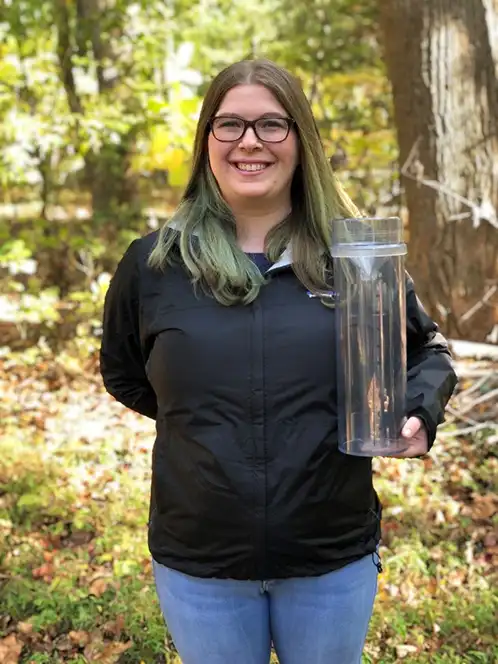EPA fellow researching extreme rainfall events to inform future changes
Meet Geneva Gray
On September 5, 1996, Hurricane Fran made landfall on the coast of North Carolina as a powerful category three hurricane. The storm brought intense rainfall while wind battered the region of Fayetteville, North Carolina. Geneva Gray, who was in kindergarten at the time, still remembers the sounds of the pine trees falling around her family home. “I was terrified yet fascinated that the world had the capacity to dole out such destruction,“ she said.

Under the guidance of her mentor Tanya Spero, Geneva Gray models extreme rainfall events that are happening today. Gray then places those events in a warmer world to see how the location, amount, and intensity of that rainfall could change in the future.
As Gray got older, she excelled in math and science. Whenever she would spend her summers with her grandparents in Illinois, her grandfather would spend time going over his engineering books full of physical equations. He would tell Gray that if she studied hard and remained focused, she would be able to go to college with the very equations she was reviewing in his books. Gray became the first in her family to attend college, studying at North Carolina State University.
Now a doctoral candidate at North Carolina State University and a mom of two young children, Gray is a current research participant of the Environmental Protection Agency (EPA), Office of Research and Development (ORD), Center for Environmental Measurement & Modeling (CEMM), Atmospheric & Environmental Systems Modeling Division (AESMD) in Research Triangle Park, North Carolina. The EPA Research Participation Programs provide college students, recent graduates, and university faculty with opportunities to participate in environmental research in areas such as air and radiation, water quality, solid waste, and emergency response.
Under the guidance of her mentor Tanya Spero, Gray models extreme rainfall events that are happening today. Gray then places those events in a warmer world to see how the location, amount, and intensity of that rainfall could change in the future. A warmer world would increase the moisture available in the atmosphere to produce precipitation, which would likely lead to more rainfall and more impactful rainfall events.
Urban areas are particularly vulnerable to extreme participation events due to the density of infrastructure and population. City engineers and planners design infrastructure guided by local ordinances to withstand rainfall events that have the probability to occur at their location and at a given frequency (or return period), such as every 25 years. These plans influence culvert capacity; neighborhood locations; siting of water lines, sewer lines, and electrical lines; and even homeowner insurance programs. However, climate change is altering extreme temperature and precipitation distributions. With more evaporated water available in the atmosphere, more precipitation can form. “This results in extreme precipitation events occurring in urban areas at unprecedented amounts and frequencies causing infrastructure built to withstand past climates to fail,” explained Gray.
Gray’s research addresses how cities such as Baltimore; Portland; and Phoenix, Arizona might plan for changing future precipitation extremes. She uses an event-based downscaling approach called “pseudo-global warming (PGW).” PGW is a technique first published in 1996 that involves simulating historical weather events that are modified with increased temperatures that reflect the projected changes to climate at some point in the future. Over time, PGW has evolved from using a prescribed, homogeneous, three-dimensional change in the temperature field to using more sophisticated and localized conditions from a suite of global climate models (GCMs). Gray’s research instead applies a temperature field derived from daily GCM output from a future period with similar placements of the jet stream and high- and low-pressure systems.
Gray’s latest research is elevating the application of PGW by using more refined statistical methods. Since climate models do not produce data at the fine-scale resolutions needed for extreme precipitation, Gray is developing a new method to explore the future of rainstorms and contextualizing it for stakeholders and practitioners with commonly used datasets. The purpose of her research is to better inform individuals on how the future of extreme precipitation may look. “Rain touches all of our lives in multiple ways and understanding the future of extreme precipitation can help us better prepare for what is to come,” she shared.
Gray is learning a lot about the technical aspects of what goes into a weather model and the best practices for going in and altering a code base that contains millions of lines. “Modeling is a key tool for a professional atmospheric scientist and understanding what is going on ‘under the hood’ is important in knowing the usability and drawbacks of using the model to understand the science questions,” said Gray, adding, “This is a valuable experience that I will use throughout my career.”
Throughout her appointment, Gray has traveled to conferences for professional development and networking with others in the field. She has presented her research at numerous conferences, including the American Meteorological Society’s Annual Meeting, Carolinas Climate Resilience Conference, the USGS Southeast Climate Adaptation Science Center’s Symposium, and more. Gray has also co-authored a paper that is undergoing peer-review at a high-profile professional journal.
Upon the completion of her appointment, Gray would like to work as a scientist researching ways to inform society on what our future climate will be like and how we can prepare for that world. “It is not always easy being a mom of two young children and a doctoral candidate, but ORISE has helped me thrive and bloom into an early career researcher that makes my family proud,” said Gray.
The EPA Research Participation Program is administered by the Oak Ridge Institute for Science and Education (ORISE). ORISE is managed for the U.S Department of Energy by Oak Ridge Associated Universities (ORAU).

